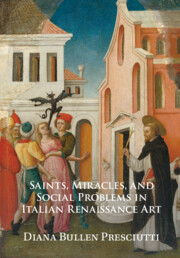Book contents
- Saints, Miracles, and Social Problems in Italian Renaissance Art
- Saints, Miracles, and Social Problems in Italian Renaissance Art
- Copyright page
- Contents
- Figures
- Acknowledgments
- One Introduction
- Two The Vita Icon Reimagined: New (and Old) Saints, New (and Old) Miracles
- Three Storytelling with Saints: Pictorial Narrative and Viewing Experience
- Four Girls in Trouble: Gendering Possession and Exorcism
- Five Assault, Amputation, Absolution: Visualizing the Power of Confession
- Six Thinking with Julian: Marital Violence and Elite Masculinity
- Seven Bernardino the Peacemaker: Visual Hagiography and Factional Violence
- Eight Cannibal Mothers: Picturing Madness and Maternal Infanticide
- Nine Making Innocence Visible (and Audible) in the Basilica del Santo
- Epilogue
- Bibliography
- Index
Six - Thinking with Julian: Marital Violence and Elite Masculinity
Published online by Cambridge University Press: 14 April 2023
- Saints, Miracles, and Social Problems in Italian Renaissance Art
- Saints, Miracles, and Social Problems in Italian Renaissance Art
- Copyright page
- Contents
- Figures
- Acknowledgments
- One Introduction
- Two The Vita Icon Reimagined: New (and Old) Saints, New (and Old) Miracles
- Three Storytelling with Saints: Pictorial Narrative and Viewing Experience
- Four Girls in Trouble: Gendering Possession and Exorcism
- Five Assault, Amputation, Absolution: Visualizing the Power of Confession
- Six Thinking with Julian: Marital Violence and Elite Masculinity
- Seven Bernardino the Peacemaker: Visual Hagiography and Factional Violence
- Eight Cannibal Mothers: Picturing Madness and Maternal Infanticide
- Nine Making Innocence Visible (and Audible) in the Basilica del Santo
- Epilogue
- Bibliography
- Index
Summary
In 1511, Titian completed his fresco of the so-called Miracle of the Jealous Husband (Fig. 87) for the Sala Priorale of the Scuola del Santo in Padua. This meeting place for the scuola, or confraternity, located just steps from the shrine of Anthony of Padua in the Basilica del Santo, was frescoed by multiple artists, over the course of the sixteenth century, with the deeds and miracles of the saint.1 Titian’s fresco depicts a miracle in which a Tuscan knight, overcome by a fit of madness and deranged suspicion, brutally beats his wife and leaves her for dead.2 Although the story fits the familiar model of the resurrection miracle, with Anthony credited with reviving the moribund woman, Titian puts the focus on the actions of the angry and violent husband. He opts for a split between the foreground, which shows the attack, and the background, where we see the guilt-ridden knight confessing to Anthony. While the outdoor setting is more informal, the background scene echoes the iconography of confession established in the previous chapter: an elite young man receives absolution for an act of violence from a mendicant friar. The bright red-and-white stripes of the husband’s dress enable the viewer to readily link the foreground and background scenes, underscoring the link between violent act and subsequent absolution.
- Type
- Chapter
- Information
- Saints, Miracles, and Social Problems in Italian Renaissance Art , pp. 188 - 220Publisher: Cambridge University PressPrint publication year: 2023



